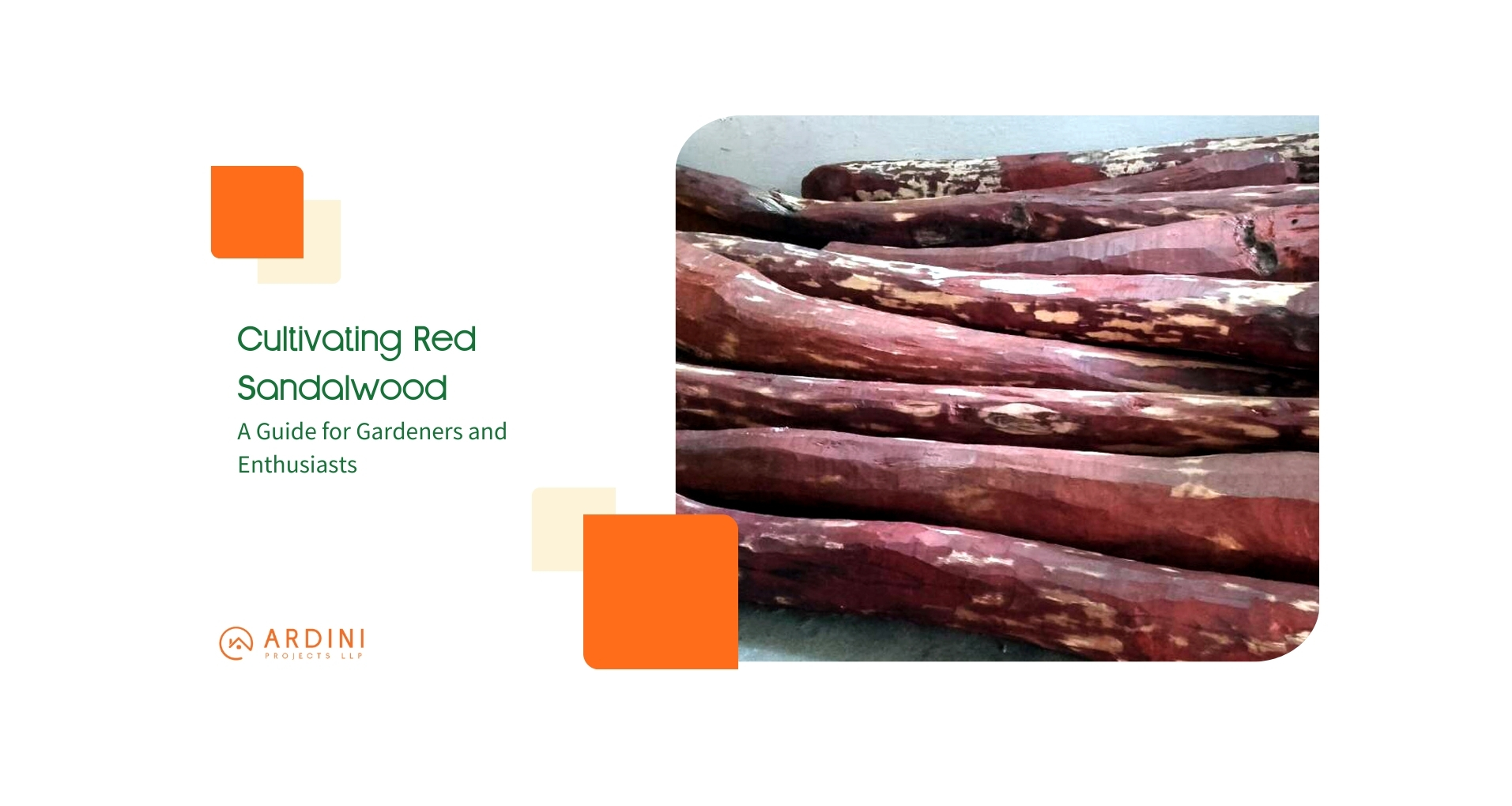Red Sandalwood Farming: Cultivation Guide

Red Sandalwood Farming opens up a captivating world for horticulture enthusiasts. Among the various plants to cultivate, the red saunders tree stands out, admired for its beauty, fragrance, and cultural significance. Known as the red chandan tree, it has captivated people for centuries. Can it thrive in your backyard or on a farm near Bangalore? Absolutely! With the right planning and dedication, you can successfully cultivate this extraordinary tree. This guide provides the essential knowledge you need to embark on your red sandalwood cultivation journey.
Understanding Red Sandalwood
The sandalwood tree is a slow-growing, evergreen species native to India. Although there are several sandalwood varieties, red sanders are particularly prized for their deep reddish-brown heartwood, which is a highly valued resource. Furthermore, red sandalwood is used extensively in both modern and traditional medicine. Additionally, it can be utilized as an antiseptic ointment and for hair care.
Why Cultivate Red Sandalwood?
There are several reasons why cultivating red sandalwood can be a rewarding experience:
Personal Satisfaction: Firstly, witnessing the slow and steady growth of this precious tree brings immense satisfaction. Nurturing a red sandalwood plant from a sapling to a mature tree is a unique and enriching experience.
Environmental Contribution: Moreover, red sandalwood is a slow-maturing tree, and responsible cultivation practices can significantly contribute to reforestation efforts and environmental conservation.
Potential Investment: Additionally, while the growth cycle is long (20-25 years), well-maintained red sanders trees can fetch a significant price due to the high demand for the heartwood. The price of a red sanders tree can vary depending on its age, size, and quality of the heartwood. However, it’s important to remember that cultivation should be driven by passion and environmental consciousness, not solely by potential financial returns.
By considering these factors, one can see that the journey of cultivating red sandalwood offers personal, environmental, and financial rewards, making it a worthwhile endeavor.
Essential Considerations for Growing Red Sandalwood
Here’s what you need to know before embarking on your red sandalwood cultivation journey:
Climate: First and foremost, red sanders thrive in warm, tropical climates with well-drained soil. Fortunately, Bangalore’s climate can be suitable for red sander cultivation, with its moderate temperatures and distinct wet and dry seasons. However, you need to consider factors like soil quality and rainfall patterns. Ensuring that the area receives adequate sunlight and protection from strong winds will further enhance the growth conditions for your red sandalwood trees.
Soil: Additionally, red sanders prefer slightly alkaline, well-draining soil. It’s crucial to avoid waterlogged conditions, as excessive moisture can hinder root development and increase the risk of root rot. If you are unsure about your soil’s suitability, consider getting a soil test to determine any necessary amendments. You might need to adjust the pH levels or improve soil structure by incorporating organic matter such as compost or well-rotted manure. These adjustments will create an optimal environment for the red sanders to establish a strong root system.
Propagation: Furthermore, red sanders can be propagated through seeds or tissue culture. While seeds take longer to germinate and require specific conditions, such as scarification and stratification, tissue culture offers a faster and more reliable option. Tissue culture involves using plant tissue to grow new plants in a controlled environment, ensuring uniformity and disease resistance. Although tissue culture may not be readily available to home gardeners due to the specialized equipment and expertise required, it is an excellent option for larger-scale cultivation projects or those with access to a professional nursery.
Planting and Care: Moreover, choose a sunny location with good air circulation for your sandalwood plant. Regular watering is essential during the initial establishment period, but overwatering should be avoided to prevent root diseases. As the tree matures, its water needs decrease, and it becomes more drought-tolerant. Additionally, provide occasional fertilizer specifically formulated for sandalwood trees to promote healthy growth. Mulching around the base of the tree can help retain soil moisture, suppress weeds, and regulate soil temperature.
Pests and Diseases: Fortunately, red sanders are relatively resistant to pests and diseases. However, it’s essential to monitor your trees regularly for any signs of trouble. Common issues may include fungal infections, leaf spots, or infestations by sap-sucking insects like aphids or scale. If you notice any problems, be vigilant and take necessary measures, such as applying appropriate organic or chemical treatments. Maintaining good cultural practices, such as proper spacing, pruning, and sanitation, can also help prevent pest and disease outbreaks.
By considering these factors and planning accordingly, you can successfully cultivate red sandalwood and enjoy its many benefits. With the right approach, your red sandalwood trees will not only enhance the beauty and biodiversity of your landscape but also provide a sense of achievement and a potential long-term investment. Whether you are a hobbyist gardener or a serious horticulturist, the journey of growing red sandalwood can be a fulfilling and rewarding experience.
Additional Tips for Success
Research and Knowledge: To begin with, in-depth research on red saunders cultivation practices is crucial. Understanding the specific requirements for soil, water, light, and nutrients will lay a solid foundation for successful growth. Additionally, consulting with experienced horticulturists or forestry experts can be immensely beneficial. These professionals can provide insights based on years of practical experience, helping you avoid common pitfalls and optimize your cultivation practices. Attending workshops, reading scientific literature, and joining forums dedicated to red sandalwood cultivation can further enhance your knowledge and skills.
Patience is Key: Furthermore, remember that red saunders are a slow-growing tree. Therefore, be patient and provide the necessary care throughout its growth cycle. This patience will be rewarded as you witness the gradual transformation of your saplings into majestic, mature trees. Regular monitoring and timely interventions are essential to address any issues that arise. Consistency in care, such as watering, fertilizing, and pruning, will ensure the trees remain healthy and robust. Accepting the long-term nature of this cultivation process can help set realistic expectations and foster a more rewarding experience.
Responsible Harvesting: Lastly, if you plan to harvest the heartwood, ensure you follow sustainable practices and obtain any necessary permits. Red sandalwood is a valuable and protected resource in many regions, including India. Adhering to legal and ethical guidelines is crucial to preserving this species for future generations. Sustainable harvesting practices include selective cutting, allowing sufficient time for regeneration, and avoiding over-exploitation of natural populations. Engaging with local forestry departments or environmental organizations can provide guidance on best practices and legal requirements.
By thoroughly researching, practicing patience, and committing to responsible harvesting, you can successfully embark on your red sandalwood cultivation journey. This comprehensive approach ensures that your efforts contribute positively to the environment and align with conservation goals. Beyond the tangible benefits of cultivating red sandalwood, such as personal satisfaction and potential financial returns, you will also be part of a broader movement towards sustainable forestry and environmental stewardship. Embracing these principles will not only enhance your cultivation success but also leave a lasting, positive impact on the ecosystem and community.
Exploring Red Sandalwood Cultivation Options
There are a few ways to explore red saunders cultivation:
- Backyard Gardener: If you have a suitable space and the necessary dedication, cultivating a single red saunders tree in your backyard can be a fulfilling experience.
- Community Farming: Consider joining a community farm or project focused on red saunders cultivation. This allows you to learn from others and contribute to a more significant effort.
- Managed Farmland: Ecowood Habitat by Ardini Projects LLP offers a unique opportunity to invest in managed farmland dedicated to red sandalwood cultivation near Bangalore. This option allows you to participate in a sustainable venture without the burden of day-to-day management.
Conclusion
Growing red sanders requires patience, commitment, and a profound admiration for nature’s beauty. You can start this fulfilling endeavor by following these guidelines and doing thorough research. Remember, responsible cultivation practices are essential to ensure the future of this precious tree. So, if you’re a gardener or enthusiast yearning to connect with the magic of red sanders, take the first step today and cultivate a legacy for generations to come.
- Tags : Cultivating, Organic Farming, Sandalwood
